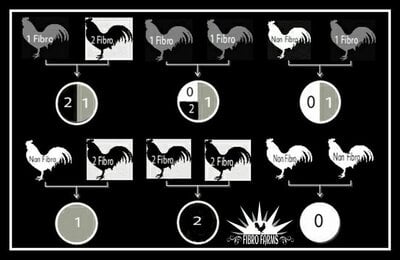- Oct 30, 2017
- 323
- 281
- 196
According to the Ayam Cemani Breeders Association “Test breeding” is the only sure way to tell if your breeders stock have two copies of “Fm”? If I understand this method correctly this is achieved by breeding all fibro males with none fibro females, and all fibro females with none fibro males. In other words breeding fibro males and fibro females with for example; Blue Ameraucanas. If the offspring are all black then your birds do have both copies of Fm. Below is a chart that illustrates the different results of this test.
I have been breeding these birds going on 5 years now and the offspring have been the best I have had thus far with very few culls. I now have approximately 20 grow-outs with excellent qualities I am considering using for this test which by no means appears easily accomplished. The males would be relatively simple although it is the females that would be difficult to keep track of. My guess is the only way would be separating each none fibro male with each fibro female until at least 10 eggs are gathered for incubation, unless I can develop some sort of method to tag or identify characteristics of each individual females eggs.
So my question is; has anyone here tried this Test Breeding method, how did you accomplish it, and what did you think of this method?
I have been breeding these birds going on 5 years now and the offspring have been the best I have had thus far with very few culls. I now have approximately 20 grow-outs with excellent qualities I am considering using for this test which by no means appears easily accomplished. The males would be relatively simple although it is the females that would be difficult to keep track of. My guess is the only way would be separating each none fibro male with each fibro female until at least 10 eggs are gathered for incubation, unless I can develop some sort of method to tag or identify characteristics of each individual females eggs.
So my question is; has anyone here tried this Test Breeding method, how did you accomplish it, and what did you think of this method?
Attachments
Last edited:




